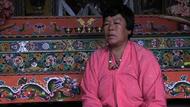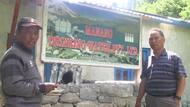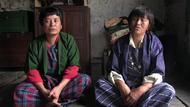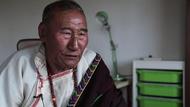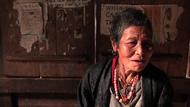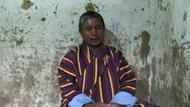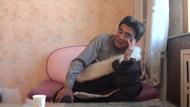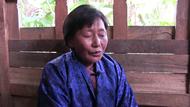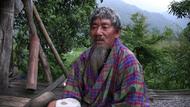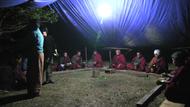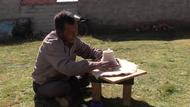Video Overview
A Gurung man describes the history of the village Taal including its development and a landslide.
- Nepal
- DAMŋəi pəila patheni tã ŋi pile õsõ pəila ŋəe mi pisjoमैले पहिला जेठो बालाई कुरा सोध्नु भन्दा अगाडी मैले नाम भन्छु।I will tell my father's elder brother my name before I ask you
- DAMŋəe mi min rasiमेरो नाम मिन रासी हो।My name is Min Rashi Gurung.
- DAMagjale pathe kjõ mi taत्यसपछि जेठो बा तपाइंको नाम के हो ?Uncle (father's younger brother), "What is your name?"
- TEKŋəe mi aslal guruŋ aslal təmuमेरो नाम आसलाल गुरुङ् (हो)।My name is As Lal Gurung.
- DAMŋəe ta ŋwil məep pisjã nəri tso taləe pisəeri ŋjol məep kjõniमैले के भन्न खोजेको भने पछि यो तालको विषयमा सोध्न खोजेको तपाईंसँग।What I like to ask you is about this village (Taal).
- DAMtal dzərdipa ŋjo kəti bərsə təeहामी ताल झरेको कति वर्ष भयो ?When did we come down to settle in Taal?
- DAM
- TEKtal dzərdibaताल झरेकोSettling down to Taal,
- DAM
- TEKkəti bərsə legə təi kətiकति वर्ष धेरै पो भयो, कति,I don't know for sure but many years have passed.
- TEKsõtsu kutsju təmne waतिन देखि नौ वर्ष सम्म भयो होला है।Perhaps it is ten to nine years, you know?
- DAMsõtsu pim pisjã nəri tsu tal kjũ dzərdib benda õsõ tal khətəpəeतिन वर्ष भन्नुहुन्छ भने यो ताल तपाइं झर्नु भन्दा अगाडि ताल कस्तोIf you say so, how was Tal (village) before you came down?
- DAMnas khətə məe khol khətə məe tĩo khətə məeगाउँ कस्तो थियो, खोला कस्तो थियो, घरहरू कस्ता थिए ?How was the village? How was the steam? How were the houses?
- DAM
- TEKtsuri ŋi dzərdiu pile õsõ tsu talə taləre õsõ ta pisjã tsuriयहाँ हामी झर्नु भन्दा पहिले यो ताल तालमा पहिले के भने यहाँ गाउँ थिएन।Before we settled here there was no village here.
- TEKta arəp mopaकेही नभएको थियो।It had nothing.
- TEKdzəŋgəl pura tsarəi tirə nədi khola tsə̃ mərsjaŋdi tsə̃ĩ kwi kholaपूरा जङ्गल चारै तिर नदि खोला चाहिं मर्स्याङ्दि चाहिं पानि खोला चाहिंThere was forest all around, the river Marsyangdi all around, and the
- TEKətəpəe tosopəe pali təpa arəpaयस्तो अहिलेको जस्तो भएको थिएन।The river was not like these days but flowed straight.
- TEKpətshtshim tʃjãbəe khlo dzəŋgəl hərabhəra təpəe khlo məpaनिकै राम्रो ठाउँ जङ्गल हराभरा भएको ठाउँ थियो (यो)।This was a very nice place, a place with green grass all around.
- TEKətəkja lisũ tsupele õsõ tatəi pisjã tsu tal tal tae lisũत्यसपछि यो भन्दा अगाडि ताल ताल भयो पछि।Later, this palce turned into a lake.
- TEKtal khəite pisjã kjaripəe kjorane tsəre lipəe akhikutũ pimuताल के भयो भने उता पट्टिको घेराङ् र यता पट्टिको आखिकुदु भन्छन्,What happened to this place is, the place on the other side is called
- TEKʈui jusi əthər tsəre tsərepəe ʈui juamneməi kui tsəri dzəmdijaiपहिरो आएर यताउताको पहिरो जमेपछि पानि यहाँ जम्यो।Having the landslide fell, and blocked the river to flow, water was
- TEKtsu tal tal pisi atikakale tal pi thẽpa tini lisõयो ताल ताल भनेर त्यसपछि ताल भने राखेको अहिले पछि,This place is now later called Taal lake after that.
- TEKkju tsə̃i ãpheijõ kja məesi atsu tal khuldiae maliपानि चाहिं आंफै बाटो खोजेर त्यो ताल खुल्यो तल।Since the water found it own way, the accumulated water flowed down.
- TEKkju tsəĩ tal phuʈisi tjarə tini tsu kju tal areपानि चाहिं ताल फुटेर अब आज यो पानिको ताल छैन।Having the lake burst, there is no water collected these days.
- TEKareछैन।The water is not there.
- TEKtsu tal pipə tsə̃i õsõ kju talməe tsu kju puraũ tõ nəmriयो ताल भन्ने चाहिं पहिला पानि ताल चाहिं यो पानि पुरै माथि सिरान तालAll area was covered with water from Siran to this place, there was
- TEKadzəsəmmə toso tsuri kjã aropaत्यतिखेर सम्म अहिले यहाँ बाटो थिएन।There was no road. This place was not connected to the road.
- TEKkjã toबाटो माथि (थियो)।The road was on the top.
- TEKbəgərtshapdo mali jusi ruŋkhu nasa ruŋkhu nasa(बाटो) बगरछाप देखि तल आएर ओढार गाउँ ओढार गाउँThe trail having passed down from Bagarchap, through Odhar
- TEKkjorã nasa kjõrãdo mali tsaĩ tsjamtse tõ məpaघेराङ् गाउँ घेराङ् देखि तल चाहिं च्याम्चे निस्किन्थ्यो।Odhar to Gherang and then down to Chjomce.
- TEKatəkja lisõ pheri tsu tal phuʈipəe lisõ teti teti ato kjatsa ləsiत्यसपछि फेरि यो ताल फुटे पछि अलि अलि त्यता यता उता गरेर यो बाटोAfter that this trail was in use slowly after the lake burst.
- TEKtsuri kri ni abə toso tsuriयहाँ एउटा दुइटा अब अहिले यहाँSlowly one after another,
- TEKkhjodo me pisi tsəĩ tshəpəe khjo thẽ tsuriगाइ वस्तु चराउने ठाउँ (छ) भनेर चाहिं यहाँ राखे ।people fixed (lit. kept cowsheds) here realizing that there was good
- TEKkhlĩ jup mopa õsõməe abe kheto bəstu to eri ʈil akhãहिउँ पर्थ्यो पहिला चाहिं । अब गाइ बस्तु माथि लेकमा बस्न सक्दैनथे।It used to snow a lot in villages in high locality. The cattle could
- TEKkheto bəstu ma bui dzərdisi tsuri khjoto prõ thĩpəe khlo mopaगाइ बस्तु तल झारेर यहाँ गाइबस्तु गोठ राख्ने ठाउँ थियो।Having brought down the cattles, this was the place to keep cattle.
- TEKlisõ ta təi pisjã tsəri nasəm le tai mi le taiपछि के भयो भने गाउँ धेरै भयो, मान्छे धेरै भए।Later, what happened is, there were many villages, and many men.
- TEKʈipəe khlo ajomniməe tsuri pheri jusi ʈijai ʈijaiबस्ने ठाउँ नपाएकोले यहाँ फेरि आएर बसे।Since they did not find the place to live, they came here to live.
- TEKatəsi tirə ʈisi tsuritja atso lisũत्यहि भएर घरमा बसेर यहाँ अब त्यसपछिBecause of that, people settled here, and then
- TEKabə tsuri tĩ titi titi bənjo tini abəअब यहाँ घर अलि अलि बने, आज अबand some houses were constructed here. Now
- TEKtinipəe əbəsthari ʈĩo leõtai toso məmaŋ dzillarbəe səbbhənda leआजको अवस्थामा धेरै घरहरू अहिले मनाङ् जिल्लाको सबैभन्दा धेरैthis is now the village with highest number of households and village
- TEKwarɖ thepə tsuruŋ tai hwatəsi tsu atətəe khlo mopaठूलो बार्ड यही भयो, हो त्यही भएर यो यस्तो ठाउँ थियो।This became the biggest ward in Manang and therefore the place was
- TEKlisũ tsu tirsəʈhʈhi agoe belari tsu ʈui jueपछि यो त्रिसठ्ठी (सालमा) त्यतिबेलामा यो पहिरो आयो।A landslide fell in the year of 2063 VS.
- TEKtsu larke pasəi huĩ phuʈerə aerə tsuयो लार्के पासको हिउँ फुटेर आएर योHaving the avalenche from Larke,
- TEKbaɖhi jueबाढी आयो।the flood came.
- TEKbaɖhi juiबाढी आयो।The flood came.
- TEKtsu dzəmmə nomiयो सबै बिगार्यो।All was destroyed.
- TEKtsu tal tsaĩ nomiयो ताल चाहिं बिगार्यो।The Tal village was destroyed.
- TEKõsõ altəp aropaपहिला यस्तो थिएन।It was not like this before.
- TEKatokjale pheri lisũ atsu bərsə lisũ pherəũत्यसपछि त्यो वर्ष पछि फेरिLater the same year again
- TEKnar phudo ma pheri tikhi ajo nikhe baɖhiनार फु देखि फेरि एकपटक (बाढी) आयो, दुईपटक आयो बाढी।the flood came down from Narphu, twice the flood came.
- TEKali ləmii tsu isthiti tsjatse nomieयसो गरिदिए यो स्थिति अलि बिगार्यो।Having done it, the condition was destroyed.
- TEKapisjã tsu tal pipa məno nasəe nasə tsillaõ oire tsokəi məteriनत्र भए यो ताल भन्ने मनाङ् गाउँको (गाउँ) जिल्ला भरि सबै भन्दा राम्रोOtherwise, this is the nicest village among the villages in Manage.
- TEKtsu khlo tʃjãpaयो ठाउँ राम्रो हो।This was a nice place.
- TEKləmdzuŋe mənoe simana tsərõ pərdi muलम्जुङ् र मनाङ्को सिमाना यही पर्छ।This is located between Manang and Lamjung.
- TEKpəile naka ei hoपहिलो नाका यही हो।This is the main entrance to Manang.
- DAMŋəe ta pil məep pisjã nəri tsu tal nasəe nas bəsti thep mo piaiमैले के भन्न खोजेको भने यहाँ यो ताल गाउँमा गाउँ बस्ती ठूलो छ भन्नुWhat I am going to ask is you to tell that this is the biggest
- DAMməno dzillarbəe səbbhənda oɖa thep piमनाङ् जिल्लाक सबै भन्दा ठूलो वडा भन्नुभयो।You said that this is the biggest ward in Manang.
- DAMali pimni matrõ tsu taləri ləmdzuŋdo to mətrei khəi ʈipo ki ŋjo monoयसो भनेर मात्र यो तालमा लम्जुङ् देखि माथि मात्रै आएर बसेछन् कि हाम्रोSaying this I want to ask whether people come up from Lamjung and sit
- DAMəkjale kaməe ɖulməe baun tshetri poiməe atəri khətəpəe dzatio le moत्यसपछि कामी दमाइ, बाहुन, क्षेत्री, भोटे त्यहाँ कस्तो जातिहरू धेरैand people of which castes (Kami, Brahmin, Bhote) are there in Taal?
- DAMhadzwe tikhi piminuत्यो पनि एक पटक भनिदिनुस्।Please also say this.
- TEKtsure pəila nəmbərməe tsuri ta pisjã ləmdzuŋne mənorpəe simana sãdhयहाँ पहिला नम्बरमा यो के भने लम्जुङ् र मनाङ्को सिमाना, साँध सिमानाFirst of all, this is a boundary of Lamjung and Manang, this is the
- TEKtemneməe tsuri dzəgəɖa pərdiत्यसैले यहाँ झगडा पर्यो ।Therefore there was a quarrel.
- TEKtsu ləmdzuŋəe ŋe dzəgga mənoi ŋe dzəgga pisi dzəgəɖa təiयो लम्जुङ्ले हाम्रो जग्गा मनाङ्ले हाम्रो जग्गा भनेर झगडा भयो।There was a quarrel because the people from Lamjung claimed it to be
- TEKdzəgəɖa təmniməe tʃhəinə tʃhəinə pheri tsu tʃuŋgui tsunoriझगडा गर्दा त झगडा गर्दा गर्दा फेरि यो सानो यो मुनि सार्वजनिक ठाउँ भएरAs there was a quarrel, and when there was a quarrel, because this is
- TEKsadze taiसाझा भयो।it was common land.
- TEKatəpnem tsu nas dzəĩ ŋi lisũ tsuri ʈiiयसो भएर यो गाउँ चाहिं हामी पछि यहाँ बस्यौं।In this way, we sat here in this land later.
- TEKʈijupneməe təsə səbbhənda le miməe nətse nasərpəe mi le ʈipəबस्न आउँदा त सबै भन्दा बढी मान्छे नाचे गाउँको बढी मान्छे बसेछन्।As people came to stay, more people from Nace happened to live here.
- TEKtəsə ruŋkhu nədze darapani kjorãअहिले ओढारगाउँ, नाचे, धारापानि, घेराङ्Here are people from Odhargaun, Nace, Dharapani, and Gherang.
- TEKatsue aləpa ləmdzuŋərpəe mio tsjatsi moत्यसको अलावा लम्जुङ्को थोरै मान्छेहरू छन्।In additon, there are some people from Lamjung.
- TEKarkonə tsu lama tãŋiŋjo mildisi səbei dzəmmaõ mildisi ʈipəe khloअर्को पनि यो लामा सबै थोक मिलेर सबै सबै बस्ने ठाउँ (हो)।Moreover, there are some Lamas and this is the place to live in
- DAMakjali kaməe ʈulməe əkjale lama dzati pipəe ʈibeʈənə kəti ti moत्यसपछि कामी, दमाइङ त्यसपछि लामा जाति भन्ने तिब्बतीहरू कति जति छन् ?How many families of Kami, Darai and Lama or Tibetans in this village?
- TEKtsəri leməe təmu təmu le moयहाँ धेरै चाहिं गुरूङ् धेरै छन्।There are more Gurung people here.
- TEKato lisũri lama lama tsjati moयहाँ पछि लामा, थोरै लामा छन्।This is followed by Lama people but they are few in number.
- TEKtĩ turi ŋaglo ti ləməe moघर धुरी पाँच ओटा जति लामा हरू छन्।There are about five households of Lamas.
- TEKkaməeni ʈulməe tĩ duri ŋjoklo moकामी र दमाई घर धुरी दुई ओटा छन्।There are two households of Kami (ironsmith) and Damai.
- TEKərkom are təmu məisjoअरू हरू छैनन्, गुरुङ् हरू मात्र (छन्)।No other castes live here, only Gurungs live here.
- DAMbathei agoi bətsən pĩ tʃjã pĩजेठाबाले यति बचन दिनु भयो, राम्रो दिनुभयो।Elder uncle gave me this much information which was good.
- DAMdənjəbadधन्यबाद !Thank you.
- TEKlə dhənjəbadल धन्यवाद !Okay, thank you.
 Loading ...
Loading ... 